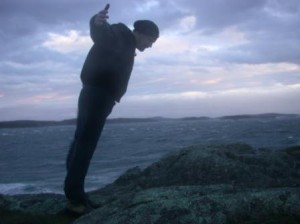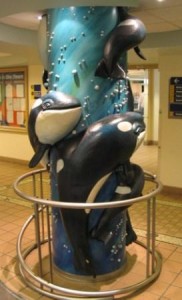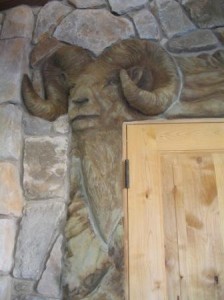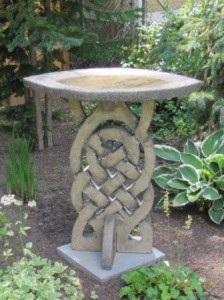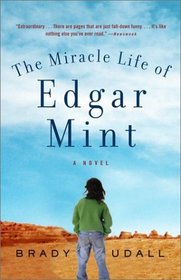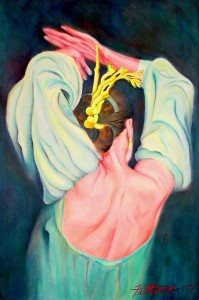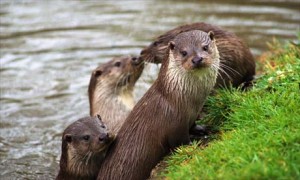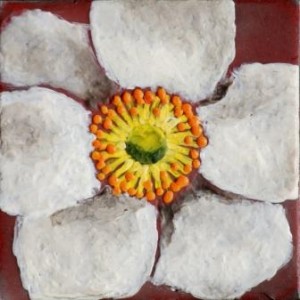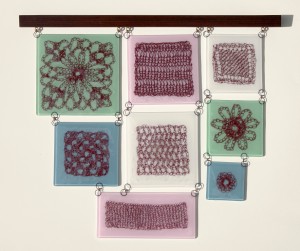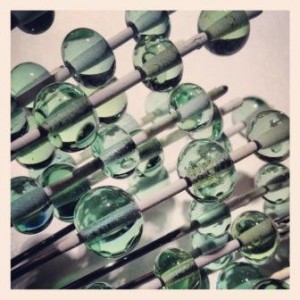Artist Peter Goetzinger
“If we are still enough, we can experience healing through art every day; in the simple act of looking out the window, gazing upon the art of creation and taking a deep breath. Art is all around us and healing takes hold when our eyes and hearts are open.”
If you have ever driven by a water tower on your way to the Washington State Fair, strolled past a mural in downtown Lewiston, or visited the Oregon Trail Interpretive Center in Baker City, Oregon, you will have seen the work of Peter Goetzinger. A Native of Lewiston, Idaho, Peter attended the University of Idaho and Utah State University, where he received a degree in Illustration with a minor in Graphic Design. He lived for several years in Seattle, where he was an active member of AMBP (Artist Made Building Parts) and served on the selection committee for the Seattle Arts Commission. His stamp on that city can be seen at the downtown REI, Seattle Children’s Hospital and Sea-Tac International Airport.
Today he resides near Sandpoint,Idaho, with his wife, artist Kelly Price, and their son, Orion. His current focus is “the wild and wooly world of public art: chasing and receiving commissions to create art for public spaces” as well as designing and creating works for medical institutions and the private sector. He serves on the Sandpoint Arts Commission where he is working with the city and a group of local artists to create a long-term vision for public art.
You can usually find Peter in his spacious workshop next to his hexagonally shaped, window-filled house. The woodstove is kept busy here, where the densely wooded lot sees more snow, moose and deer than Sandpoint, about twelve miles south. When he’s not in his shop, Peter can be found playing the piano, on nearby Schweitzer Mountain, or searching for treasures at the local dump.
Peter, thank you for speaking with Healing Hamlet about your ongoing artistic journey! Can you please tell us what draws you to create art?
I’ve been creating art as long as I can remember. When I was little, my brother and I would spend hours drawing through reams of paper on Saturday mornings. Fortunately, my parents valued my artistic spirit and never attempted to douse that flame. There never really seemed to be a question in my mind as to what I wanted to be when I grew up.
I was talking recently to someone about why I’ve chosen art as my life’s pursuit and I didn’t have a “why” answer. I said it’s just what I have to do – kind of my default setting. If I were to create a mission statement I guess I’d have to say that one of my deepest goals is to add beauty to the world.
Your art has been incorporated into medical offices and hospitals. How can art or the creation of art promote healing?
In the medical realm, “adding beauty” also translates into creating meaningful distractions. At Children’s Hospital, for example, I’ve created pieces that are meant to compliment their surroundings and be interesting or pleasing to the eye. But they also serve the purpose of distracting from the hurts, confusions and anxieties that often accompany a visit or stay in a hospital, even if it’s just for a moment. Art can help create a sense of the familiarity and warmth in a place which is unfamiliar and sometimes even frightening. It provides a place where the mind and heart can go to feel safe.
Public art is an important part of your work. What role do you think art plays in the well being of a community?
I find myself becoming increasingly interested and curious in exploring history through public art. Every community has an interesting history and every person has a story. In my experience many people don’t know the history of where they live and public art is a great venue for exposing people to their past. I believe that when people understand their community’s history they will be more likely to participate in its future.
You integrate nature into many of your sculptures, bringing the outside world into indoor spaces. Why do you think it’s important for us to be surrounded by nature?
Nature shows us how we are all bound together for better or worse, and how we are all, as individuals, part of something greater than ourselves. We all have nature in common and I think many people recognize this. Nature can also symbolize aspects of our lives. Images, especially those of animals, are interpreted as personal metaphors. I often ask clients what kind of imagery is important to them and most of the time the answer leads to something from nature.
You have created a beautiful series of garden sculptures. Why are gardens important to you?
Gardens are one of the places I go for nurturing and healing. I find it therapeutic to get my hands into the warm soil; maybe I just like to play in the dirt and this is a grown-up way to do it. A garden is my connection to Mother Earth and Mother Earth gives back in great measure with just a little effort on my part.
What artists/artworks do you turn to for inspiration?
One artist I find particularly inspiring is Andrew Goldsworthy, the British artist who finds inspiration and materials from the natural world around him. I appreciate his depth of thought, his playful whim and his earth-honoring sensibilities. Just the other day I discovered the work of Janet Echelman, another artist in the public art realm. Her imagination and innovation pushes the boundaries of design and materials. I also admire her sense of curiosity and exploration.
Have you witnessed or do you have any personal experience connecting art and healing?
The Combination of art and healing manifests itself in many ways. I’ve experienced it walking into a great cathedral and I’ve experienced it being in a culture (Bali) that has merged art with spirituality in daily life. It was not only healing, it was liberating. I remember when the Gulf War was declared and I was at a Sweet Honey in the Rock concert. I was upset because of the onset of war, yet when the group began to sing I welled up with tears; partly as a release of anxiety, but also in the reassurance that there is greatness, love and sweetness in the human experience. I also believe that if we are still enough, we can experience healing through art every day; in the simple act of looking out the window, gazing upon the art of creation and taking a deep breath. Art is all around us and healing takes hold when our eyes and hearts are open.
Peter, thank you for gifting us with your art and insights!
Peter Goetzinger, along with his brother, Rolf Goetzinger, are Artist Brothers. You can learn more about Peter, Rolf and their artwork at Artistbrothers.com.
The Miracle Life of Edgar Mint
A Novel by Brady Udall
If I could tell you only one thing about my life it would be this: when I was seven years old the mailman ran over my head. As formative events go, nothing else comes close; my careening, zigzag existence, my wounded brain and faith in God, my collisions with joy and affliction, all of it has come, in one way or another, out of that moment on a summer morning when the left rear tire of a United States postal jeep ground my tiny head into the hot gravel of the San Carlos Apache Indian reservation.
With this unbelievably horrendous event, we are launched into the miraculous life of Edgar Mint, born on an Apache Reservation and abandoned to a hospital at age seven. Alone in the world with only a blue urinal cake to rub for comfort, Edgar endures and survives life’s adversities with hope, humor and an astonishing absence of bitterness.
Learn more about The Miracle Life of Edgar Mint and Brady Udall on his author page.
Ole!
Lisa Fittipaldi
Artist and Author Lisa Fittipaldi began painting after losing her vision to Churg-Strauss Vasculitis. You can view more of her paintings here. Explore her books and discover more about her amazing journey on her website.
Just the Way You Are
7 Year Old Matty B Raps for His SisterRemix of Just the Way You Are by Bruno Mars
The First Post!
Artist Staci Thompson Adman
Staci Thompson Adman is an artist and community activist who has lived most of her life in the Seattle area. She received an AA degree from Cottey College in Nevada ,Missouri and a BFA in Painting from the University of Washington. As well as pursuing her own art projects, Staci keeps involved in several community, environmental and philanthropic activities.
Last week, Staci invited Healing Hamlet into her artist studio on a wooded property of Kenmore,Washington. It was candy for the senses. She shared recent sketches, encaustic paintings, glass etchings and recycled glass beads. She even fired up her blow torch to demonstrate bead making techniques.
Staci, thank you so much for doing the first artist interview for Healing Hamlet! Can you tell us how long have you been creating art?
I’ve been drawing and creating things all of my life. I was surrounded by family who were always making things with their hands. I had access to all sorts of tools and materials to make stuff with, and my parents and grandparents have shared their skills with me all of my life.
My first serious art class (outside of middle and high school art classes) was a fantastic teen drawing class that I took at The Factory of Visual Arts, which was located at the Good Shepherd Center in Wallingford. The coolest thing was that Pacific Northwest Ballet was housed there, too, so when you stepped in the door all of your senses experienced art. In college I switched from being a Pre-Med to an Art major after my first year at Cottey College in Missouri and graduated with a BFA in Painting from the UW. Now I enjoy taking the occasional workshop, mostly at Pratt Art Center in Seattle, to learn how to work with new materials.
What has been your involvement in the art community?
My favorite community involvement has been teaching art as a volunteer in classrooms and working with children on art-related projects. My favorite local art projects have to be the two kids’ art projects that I coordinated that were included on the playground at St. Edwards State Park in Kenmore,Washington. I also had a blast overseeing the chalk art area at Kenmore’s Good Ol’ Days festival. I am a member of the Arts of Kenmore board and I’m currently coordinating this year’s School Art Grants awards. I am a member of the Kenmore Art Show steering committee and had the honor of serving on the committees that helped choose the artists for major art projects included in both the new city hall and new fire station in Kenmore. I am also part of a committee working on the creation of a Veteran’s Memorial inKenmore.
What are your other interests and activities, such as your huge efforts in local environment issues and other volunteer work? Please give us the big long list. Don’t be shy. We want to know all about you.
I was honored to be chosen as the recipient of the Kenmore Heritage Society’s McMaster Award last year for contributions to the community. I just keep getting sucked into great volunteer opportunities. The best part is connecting with new, interesting people.
I am a King County Master Recycler Composter and a King County Salmon Watcher (which means I watch for and count returning salmon every fall at my assigned spots on Swamp and Little Swamp Creek). I created a Little Swamp Creek blog to record what we see happening along the creek and to document the success of the restoration work done along it in our yard by Adopt-A-Stream and the LEAFSchool. I am a member of PEO, an international women’s philanthropic organization. Actually, I’m my PEO chapter’s treasurer, and I have come up with and produced a couple of glass projects that we sell as ongoing fundraisers. I helped to plant the Blue Trees along the Burke Gilman Trail in Kenmore. Next spring I will be taking on a volunteer job on the Iron Goat Trail, located near Stevens Pass. Looks like I enjoy things that involve being outdoors and/or creativity! I love live music performed by people I know, and I love creative, alternative, not-mainstream music. I’m very taken by yarnbombing, a type of “street graffiti” where knitting/crocheted work is put on stuff. I recently sewed nine vests for InglemoorHigh School’s production of Pride and Prejudice, which was a fun project to be a part of
Now that we know a little bit about you, let’s talk about the role of art in your life. What draws you to create art?
I’d say it’s just instinctive and part of who I am. I think I have a compulsive and/or impulsive need to make art and things and to get ideas out of my head. I think I’ve always wanted to make stuff and to see what new things I could do with any given material. I’ve also felt the need to record the world around me, to remember a striking juxtaposition of things or an interesting texture or color or lighting.
What function do you feel art plays in the world and in healing?
I believe that art can add an extra layer to the world. A layer of beauty and a mode for spreading creative, thoughtful inspiration in others. Art can make people notice something or think about something in a whole new way. Art can evoke feelings, both good and bad.
Right off the bat I can think of two major ways that art can help with healing. First of all, someone may encounter a piece of art or artistic expression (a painting, photograph, film, etc.) that makes them realize that they are not alone in experiencing whatever they are hurting or recovering from, and sometimes we achieve a bit of comfort in knowing that we aren’t alone in feeling the way we do about something. Secondly, creating art inspired by how one is feeling can be therapeutic; similar to how talking to someone can make you feel a lot better. Getting something off of your chest, so to speak. Whether a person has a very physical art experience, such as covering a piece of paper with emotionally charged mark-making, or has a slow, contemplative, experience in the thousands of quiet stitches of a knitting or sewing project, for many of us I think there is huge value in getting those feelings out via artistic expression.
Was there a time when creating art helped in your own healing? How did it help you?
First of all, my creative work makes me feel a strong, ongoing connection to my mom and my grandparents, who have all passed away but were huge influences on my artistic being and who I still miss terribly. When my mom died I composed a poem for her which gave me a surprising amount of comfort and the ability to deal with the sadness and start to move forward. One of our sons was diagnosed with Type 1 diabetes in junior high school. I created several pieces of art inspired by that surprising event. A few of the pieces include insulin bottles that I slumped in my kiln until they were flat, an act in itself which might be interpreted in interesting ways. If anything, the diabetes-inspired art helped me as much as anything because I was taking some time out for myself to sit down and just make art and get some feelings out of my head and into the open.
Can you describe any experiences where you witnessed art or the creation of art causing change or healing?
I have friends who have used journaling, including writing and drawing, to work through difficult times. I do believe my favorite experiences along the lines of witnessing change have been when I’ve worked in classrooms and seen kids work on art projects that made them feel really good about themselves when they saw what they were able to do. But I’ve also witnessed how good adults can feel about themselves when they’ve created something that they feel was a success. It’s especially fun if they never thought they could do what they did. I love that art and creativity can provide this kind of opportunity and these kinds of feelings.
What artists/artworks do you turn to when you need inspiration or healing?
At this point I think I turn to music for calming/comfort/inspiration as much as anything. And take walks for the same reason. Lately I’ve been inspired by glass and small-scale metalwork. I visit art museums and check out books from the library for artistic inspiration. Making beads on my torch or working on a knitting project can be a very meditative, relaxing task to work into my day. And I think it’s very healthy!
What else should we should know about you?
My proudest accomplishments are my two boys. I love that we are at the point where I get to sit back and watch who they are becoming. I’m so happy that they are both creative, open-minded, kind-hearted and deep thinkers.
Staci, thank you so much for sharing your time, wisdom and artwork with Healing Hamlet!
Find out more about Staci Thompson Adman at Studiowhimsy!
Healing Art, Stories and Music
A healing place for all, Healing Hamlet is an exploration of healing and art. Your journey toward peace begins here, through the healing power of art, stories, books, poetry, and music. Please read about our mission. You are invited to browse through our pages to discover beauty, hope, and joy and to share your own healing inspiration. Welcome to your hamlet of healing!
